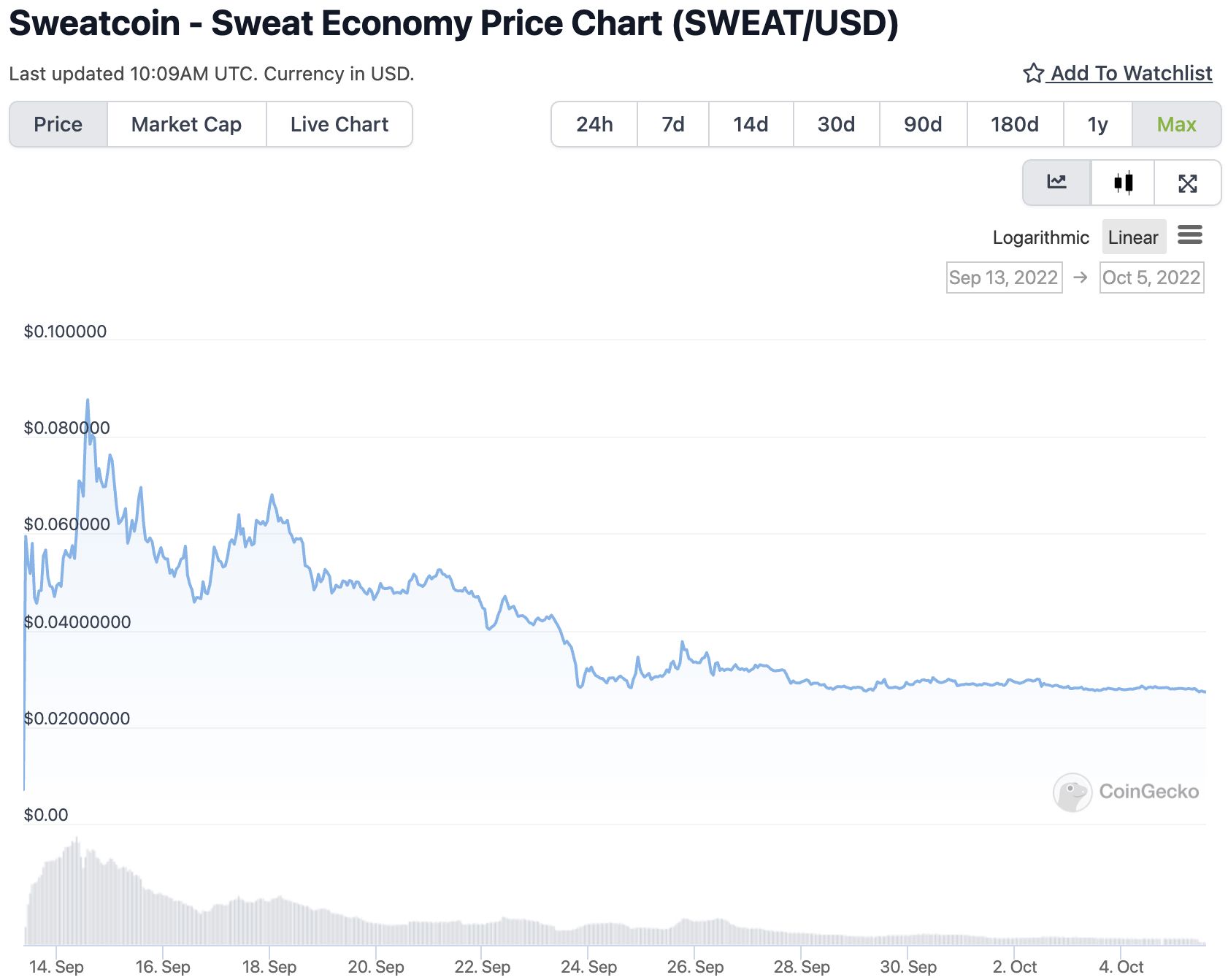SWEAT officially launched on 13 September 2022, and $1 million worth of tokens were already sold on Maker DAO before its market arrival—signifying a clear change from the platform’s initial in-app format.
With over 40,000 individuals participating in SWEAT’s public sale, it took just 15 minutes to sell out.
Accompanying SWEAT is a brand new Sweat Wallet app—which offers advanced cryptocurrency wallet features like NFT storage and staking. Significantly, the wallet features options for users to transfer, buy, grow, and exchange the SWEAT that they accumulate.
What’s the Difference Between Sweatcoin and SWEAT?
For the most part, the introduction of SWEAT doesn’t directly impact Sweatcoin. Users can continue to build their Sweatcoins and exchange them on the platform’s dedicated marketplace.
Upon its 2015 launch, Sweatcoin offered a concept ahead of its time. The app connected to health apps to monitor the steps taken by its owner throughout the day and rewarded them in Sweatcoins, known within the app as SWC.
It was then possible to exchange SWC for items listed in the Sweatcoin marketplace, which often featured discounts for fitness products or sustainable goods.
Despite growing its user base to around 110 million, Sweatcoin’s marketplace was often a little limited in terms of available options. However, the arrival of SWEAT opens the door to far more functionality.
So, how can SWEAT help to revolutionize fitness beyond the capabilities of its predecessor, Sweatcoin? Let’s take a deeper look at one of the world’s most unique new crypto assets:
1. Building a Fitness Crypto Economy
Never before has it been so rewarding to run and walk. With this in mind, everyone who takes steps using the Sweatcoin app is rewarded for their activity.
In building an economy based on movement, Sweatcoin has decided to pay out one Sweatcoin for every 1,000 steps taken. However, the company has taken on some additional measures with the launch of its own cryptocurrency to safeguard the value of its coin by gradually increasing the level of work that needs to be done to claim a new Sweatcoin.
In an interview with AltFi, Oleg Fomenko, Sweatcoin co-founder and CPO, said:
Sweatcoin is created by the value of your physical activity and the more active you are the more sweatcoins you can earn. The value of physical activity and increasing marginal cost of production means that you will actually be asked for more and more physical activity.
The breakdown of SWEAT payouts for 1,000 steps shows that rewards will fall significantly over the course of a year, with 1,000 steps returning around 0.333 SWEAT by 2024, 0.19 SWEAT by 2025, and 0.02 SWEAT in 2031.
This means that although the number of steps that will generate SWEAT will remain at 1,000 steps per SWEAT until 2024, the reward for the steps will decrease over time.
This helps to ensure that markets aren’t inundated with SWEAT coins which helps to retain their value, which is good news for Sweatcoin’s bustling digital marketplace, where users can redeem their coins for sporting goods and healthy diet plans.
2. Monetary Rewards for Exercise
For the first time in Sweatcoin’s seven-year history, the arrival of a verified SWEAT cryptocurrency means that users have the potential to trade their earnings for other coins, which can ultimately be cashed out into fiat money.
As we can see from CoinGecko’s charts for SWEAT, the asset, launched in September 2022, briefly peaked at an impressive early value of over $0.08, though it has fallen since to around $0.027 at the time of writing.
Although this may not represent much of a return for going to the effort of taking 1,000 steps today, the coin’s growing functionality and built-in tokenomics mean that accumulating more SWEAT may potentially be a lucrative investment.
Although the Sweat Wallet app is yet to enable its built-in crypto exchange, this will eventually encourage users to use their SWEAT coins to exchange for Bitcoin, Ethereum, and various altcoins.
3. The Value of Your Earnings is Safeguarded
Sweatcoin’s ambitions are made all the more impressive when considering the ongoing cryptocurrency market downturn. Despite many altcoins shedding much of their value, Fomenko believes that SWEAT will be immune to the same levels of volatility.
There is no doubt that this token is worth something. It cannot be equal to zero because fitness is valuable. The market will decide how much the value is.
One of the driving forces behind maintaining SWEAT’s value will be coin burning, which occurs when cryptocurrencies are sent to a wallet that can receive coins but can’t spend them—effectively removing them from the market.
With as many as 137 million users and an estimated 26 million Sweatcoins minted on the coin’s 13 September launch date, SWEAT will already be greater in circulating supply than the likes of Bitcoin, which has around 19m BTC minted to date.
However, Sweatcoin also committed to burning 4.5 million SWEAT upon launch, helping to reduce the circulating supply. By October 2022, Sweatcoin’s live counter states that just over 27.5m SWEAT had been created, indicating that more individuals have been working to generate more Sweatcoins in this new cryptocurrency-based format.
Cryptocurrency burning can help to ensure that a coin retains enough scarcity to ensure that it keeps its value over time. In deploying this form of tokenomics, Sweatcoin can help maintain a steady price accumulation level for its asset over time.
4. Work Your Way into a Thriving Investment Ecosystem
Impressively, Sweatcoin has also introduced a suite of investment features within its new Sweat Wallet app. The platform promises up to 12% annual earnings for individuals who choose to stake their SWEAT in what the app labels “growth jars.”
Staking is a more environmentally-friendly approach to cryptocurrency blockchains and has become popular on the Ethereum, Solana, Polkadot, Algorand, and Cardano protocols. Proof-of-stake (PoS) blockchains use validators instead of miners, which help to safeguard the network by staking a certain level of the chain’s native cryptocurrency.
This essentially helps them to lock in cryptocurrencies, which can subsequently be used to validate transactions on the blockchain.
In utilizing staking, Sweatcoin has opened up its network to deliver rewards for users who would like to invest the coins that they work to receive.
5. Embrace NFTs and Crypto Donations
Another exciting development within the Sweatcoin Wallet app revolves around the alternative functions that SWEAT can serve–such as buying exclusive NFTs or donating to worthy causes.
Sweat Wallet features its own dedicated section that can store non-fungible tokens, and NEAR wallet functionality means that NFTs can be sent and received within the app. Furthermore, Sweatcoin indicates that it’s ready to embrace NFTs in the future by including non-fungible token prize draws within the app’s marketplace. At the time of writing, Sweat Economy has partnered with Paras to offer users one of 888 NFTs in an exclusive prize draw for users who are staking their coins.
Alternatively, Sweatcoin has often allowed its community the opportunity to donate their earnings to charitable causes like sustainability projects and humanitarian disaster appeals.
Sweatcoin: A Health-Conscious Rewards Ecosystem
Although the emergence of the newly dubbed “Sweat Economy” is still in its fledgling stages, the early signs point to a vibrant earning ecosystem with a growing range of investment and spending options for a 137 million-strong user base. Should SWEAT fulfill its potential, the task of embracing exercise may have never been so rewarding.



